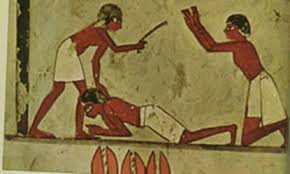The Lives and Struggles of Ancient Egyptian Slaves
Discover the daily lives, roles, and struggles of slaves in Ancient Egypt. Explore their conditions, societal impact, and cultural perspectives.
The Historical Context of Slavery in Ancient Egypt
Slavery in Ancient Egypt was an integral part of the social and economic fabric. Understanding the experiences of slaves from Egypt involves exploring their origins, roles, and the evolution of this institution over centuries.
Origins and Evolution of Slavery in Ancient Egypt

Slavery in Ancient Egypt can be traced back to the early dynastic periods. Initially, the primary sources of slaves included prisoners of war, debtors, and those born into servitude. The institution evolved significantly over time, influenced by Egypt’s expanding empire and economic needs.
- Early Dynastic Period: Slavery began with the enslavement of war captives.
- Middle Kingdom: Slavery became more structured, with slaves being used in agriculture, construction, and households.
- New Kingdom: The practice expanded with Egypt’s imperial conquests, leading to a larger and more diverse slave population.
Types of Slaves in Ancient Egypt
Slaves from Egypt were categorized based on their roles and origins. Each type of slave had distinct responsibilities and conditions:
- Domestic Slaves: Worked within the household, performing tasks such as cooking, cleaning, and childcare.
- Labor Slaves: Employed in agricultural fields, construction projects, and mines. Their work was often grueling and dangerous.
- Prisoners of War: Captured during military campaigns, these slaves were often used for labor or as personal servants.
Daily Life and Living Conditions of Slaves
The daily life of a slave in Ancient Egypt varied greatly depending on their role and location. However, several common themes emerged regarding their living conditions:
- Housing: Slaves typically lived in modest quarters, often separate from their masters’ homes. In urban areas, they resided in small, cramped spaces.
- Diet: Their diet was basic, consisting mainly of bread, onions, and occasionally fish or meat. The quality of their diet depended on their master’s generosity.
- Clothing: Slaves wore simple garments, often made from coarse linen. Their clothing was practical but not luxurious.
- Work Environment: Work conditions ranged from relatively benign domestic tasks to harsh and backbreaking labor in mines and fields.
“The treatment of slaves was as varied as their roles. While some enjoyed relative comfort, many endured harsh conditions and limited rights.” – Historical Perspectives on Ancient Egypt
Social and Economic Impact of Slavery
Slavery’s Role in the Egyptian Economy
Slavery played a crucial role in the economic structure of Ancient Egypt. Slaves contributed significantly to various sectors:
- Agriculture: Slaves worked the fields, growing crops such as wheat and barley, which were vital to Egypt’s economy.
- Construction: Many monumental structures, including temples and pyramids, were built using slave labor.
- Mining: Slaves were employed in dangerous mines, extracting valuable resources like gold and copper.
Social Hierarchies and the Status of Slaves
In Ancient Egyptian society, slaves occupied the lowest social tier. Their status was markedly different from free citizens:
- Social Position: Slaves were considered property rather than individuals with rights. They were often subjected to harsh treatment and had little recourse against mistreatment.
- Comparison to Other Classes: Unlike artisans and traders, slaves had no social mobility and were excluded from many aspects of public life.
Legal and Cultural Aspects of Slavery
Legal Status and Rights of Slaves
The legal framework surrounding slavery in Ancient Egypt was limited. While some rights were granted, they were minimal:
- Legal Rights: Slaves had few legal protections and were often at the mercy of their masters. Legal disputes involving slaves were typically resolved in favor of their owners.
- Punishments: Slaves faced severe punishments for disobedience or rebellion, including physical beatings and execution.
Cultural and Religious Perspectives on Slavery
Slavery was deeply embedded in Egyptian culture and religion:
- Cultural Views: Slavery was accepted as a norm, and slaves were often depicted in art and literature as part of the daily life of the elite.
- Religious Perspectives: Egyptian religion did not explicitly condemn slavery. Some religious texts even included references to slaves in the context of temple service and offerings.
Rebellions and Resistance
Forms of Resistance and Rebellion
Despite their subjugated status, slaves occasionally resisted their conditions:
- Rebellions: There were several recorded instances of slave revolts, though these were relatively rare and often quickly suppressed.
- Acts of Resistance: Slaves employed various methods to resist, including work slowdowns, sabotage, and escape attempts.
The Impact of Rebellions on Egyptian Society
Rebellions had a significant impact on both the institution of slavery and Egyptian society:
- Consequences: Rebellions led to harsher treatment and stricter controls over slaves. They also prompted changes in policies to prevent future uprisings.
- Societal Changes: Some revolts resulted in temporary shifts in social and legal practices concerning slavery.
Legacy and Modern Understanding

Historical Legacy of Slavery in Ancient Egypt
The legacy of Ancient Egyptian slavery has influenced various civilizations and historical interpretations:
- Influence on Later Civilizations: The practices and structures of Egyptian slavery impacted subsequent cultures and empires.
- Evolution of Understanding: Modern scholars have increasingly recognized the complexity and brutality of Ancient Egyptian slavery.
Modern Interpretations and Relevance
Contemporary perspectives on Ancient Egyptian slavery offer valuable insights:
- Scholarly Perspectives: Modern historians and archaeologists provide a nuanced understanding of slavery’s role and impact.
- Relevance: These perspectives help contextualize ancient practices within broader discussions of human rights and historical injustices.
Summary of Key Figures
| Name | Role | Description |
|---|---|---|
| Domestic Slaves | Household Workers | Performed daily tasks within the home, including cooking and cleaning. |
| Labor Slaves | Field and Mine Workers | Engaged in strenuous and often dangerous labor, including agriculture and construction. |
| Prisoners of War | Captives | Enslaved as a result of military conquests, used in various roles, from labor to domestic service. |
Feel free to adjust or expand the content based on specific needs or additional research.
References:
- What Was It Like to Be a Slave in Ancient Egypt? https://www.historydefined.net/
- Ancient Egyptian Slavery – Wikipedia https://en.wikipedia.org/wiki/Slavery_in_ancient_Egypt






